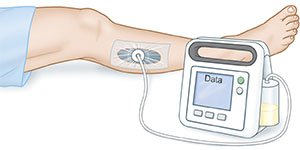Negative Pressure Wound Therapy
Medically reviewed by Drugs.com. Last updated on Jul 7, 2024.
NPWT uses a machine called a wound vac, wound vacuum, or pump to help with wound healing. Suction from the machine removes excess drainage from your wound and pulls wound edges closer together. NPWT promotes healthy tissue growth by increasing blood flow to your wound. NPWT also reduces bacteria that causes infections. You and your healthcare providers will be taught about your specific NPWT machine, alarms, and dressing changes.
 |
DISCHARGE INSTRUCTIONS:
Seek care immediately if:
- You have a sudden increase or large amount of blood from your wound.
- You have a fever of 102°F or more.
Contact your healthcare provider if:
- You have a fever or nausea, or you vomit.
- Your wound or skin around your wound is red, swollen, and feels warm.
- You see pus coming from your wound or it smells bad.
- You are dizzy or confused.
- You have questions or concerns about the machine, your condition, or care.
Follow up with your healthcare provider as directed:
Your healthcare provider will need to monitor your wound. Write down your questions so you remember to ask them during your visits.
How NPWT works:
Moist foam packing or gauze is placed in your wound. Suction tubing may already be implanted within the foam. If not, tubing will be placed in the middle of the foam or gauze. Then your wound and part of the tubing will be covered completely by a clear dressing. The tubing is attached to a collection canister on the machine. Your healthcare provider may set the machine for continuous or periodic suction.
Shower with the dressing in place:
Do not remove your dressing unless directed. Ask your healthcare provider for more information. Do not take the machine into the bathtub or shower with you.
NPWT is used 24 hours a day:
If the NPWT machine is turned off for 2 hours or more, the dressing needs to be replaced. Ask your healthcare provider what type of dressing to use.
© Copyright Merative 2024 Information is for End User's use only and may not be sold, redistributed or otherwise used for commercial purposes.
The above information is an educational aid only. It is not intended as medical advice for individual conditions or treatments. Talk to your doctor, nurse or pharmacist before following any medical regimen to see if it is safe and effective for you.
Learn more about Negative Pressure Wound Therapy
Care guides
Further information
Always consult your healthcare provider to ensure the information displayed on this page applies to your personal circumstances.
